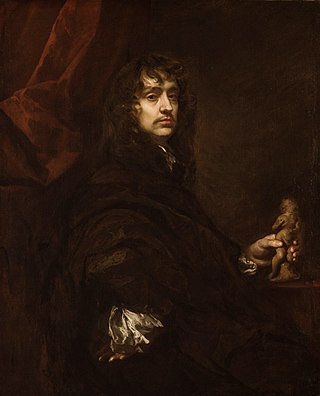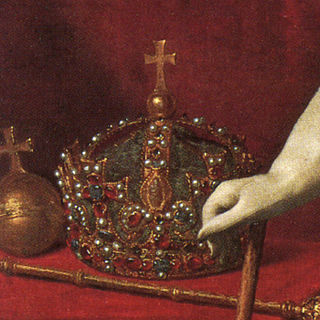Related Research Articles

Buckingham Palace is a royal residence in London and the administrative headquarters of the monarch of the United Kingdom. Located in the City of Westminster, the palace is often at the centre of state occasions and royal hospitality. It has been a focal point for the British people at times of national rejoicing and mourning.

The Crown Jewels of the United Kingdom, originally the Crown Jewels of England, are a collection of royal ceremonial objects kept in the Jewel House at the Tower of London, which include the coronation regalia and vestments worn by British monarchs.

St Edward's Crown is the centrepiece of the Crown Jewels of the United Kingdom. Named after Saint Edward the Confessor, versions of it have traditionally been used to crown English and British monarchs at their coronations since the 13th century.

The Imperial State Crown is one of the Crown Jewels of the United Kingdom and symbolises the sovereignty of the British monarch. It has existed in various forms since the 15th century. The 1937 version is worn by a new monarch for the first time in the royal procession following their coronation and subsequently used at State Openings of Parliament. The crown is adorned with 3,170 precious stones, including the Cullinan II diamond, St Edward's Sapphire, the Stuart Sapphire, and the Black Prince's Ruby.

The National Portrait Gallery (NPG) is an art gallery in London that houses a collection of portraits of historically important and famous British people. When it opened in 1856, it was arguably the first national public gallery in the world that was dedicated to portraits.

The Crown of Queen Adelaide was the consort crown of the British queen Adelaide of Saxe-Meiningen. It was used at Adelaide's coronation in 1831. It was emptied of its jewels soon afterwards, and has never been worn since.
The office of the Surveyor of the King's/Queen's Pictures, in the Royal Collection Department of the Royal Household of the Sovereign of the United Kingdom, is responsible for the care and maintenance of the royal collection of pictures owned by the Sovereign in an official capacity – as distinct from those owned privately and displayed at Sandringham House and Balmoral Castle and elsewhere. The office has only been full-time since 1972. It now operates in a professional capacity with a staff of a dozen people. As of the end of 2020, the position has been put in abeyance.
The office of Surveyor of the King's/Queen's Works of Art in the Royal Collection Department of the Royal Household of the Sovereign of the United Kingdom is responsible for the care and maintenance of the royal collection of works of art owned by the Sovereign in an official capacity, about 700,000 objects - many of museum quality. The collection is spread across the various official and historic residences. Those objects in the official residences are in constant use. Objects in the Royal Collection are distinct from those objects owned privately and displayed at Sandringham House and Balmoral Castle and elsewhere. The Surveyor oversaw conservation of works of art: there are three conservation workshops, including a recently constructed workshop in the Home Park, Windsor.
Sir Hugh Ashley Roberts, is a British art historian and curator.
Sir Geoffrey de Bellaigue was Surveyor of the Queen's Works of Art from 1972 to 1996. His was the first full-time appointment to the office, and he did much to professionalise the Royal Collection department after being made the Director of the Royal Collection in 1988.
The Institute of Historical Research (IHR) is a British educational organisation providing resources and training for historical researchers. It is part of the School of Advanced Study in the University of London and is located at Senate House. The institute was founded in 1921 by A. F. Pollard.
Sir Nicholas Beaver Penny is a British art historian. From 2008 to 2015 he was director of the National Gallery in London.

Sir Peter Lely was a painter of Dutch origin whose career was nearly all spent in England, where he became the dominant portrait painter to the court. He became a naturalised British subject and was knighted in 1679.
Sir Oliver Nicholas Millar was a British art historian. He was an expert on 17th-century British painting, and a leading authority on Anthony van Dyck in particular. He served in the Royal Household for 41 years from 1947, becoming Surveyor of The Queen's Pictures in 1972. He was the first Director of the Royal Collection from 1987. He served in both offices until his retirement in 1988.

The Royal Collection of the British royal family is the largest private art collection in the world.
Sir James Gow Mann was an eminent figure in the art world in the mid twentieth century, specialising in the study of armour.
Sir Jonathan Mark Marsden, is an art historian, curator and courtier.
Margaret Dickens Whinney was a British art historian who taught at the Courtauld Institute of Art. Her published works included books on British sculpture and architecture.

The Tudor Crown, also known as Henry VIII's Crown, was the imperial and state crown of English monarchs from around the time of Henry VIII until it was destroyed during the Civil War in 1649. It was described by the art historian Sir Roy Strong as "a masterpiece of early Tudor jeweller's art", and its form has been compared to the crown of the Holy Roman Empire.
Delia Mary, Lady Millar C.V.O., was the wife of the British art historian and Surveyor of the Queen’s Pictures, Sir Oliver Nicholas Millar and an art historian in her own right. A specialist in the art of the Victorian era, she was appointed Commander of the Royal Victorian Order in recognition of her services to the Royal Collection.
References
- ↑ "The Crown Jewels". The British Monarchy. n.d. Retrieved 9 February 2015.
- ↑ "The Royal Collection". The British Monarchy. n.d. Retrieved 9 February 2015.
- ↑ Whitaker's Concise Almanack 2012 (144 ed.). London, UK: Bloomsbury. 2012. p. 28. ISBN 9781408130124.
- 1 2 Corby, Tom (17 May 2007). "Sir Oliver Millar: Eminent art historian who nurtured the Queen's paintings but was caustic about some of them". The Guardian. Retrieved 30 January 2015.
- ↑ "Sir Geoffrey de Bellaigue". Telegraph. 9 January 2013. Retrieved 30 January 2015.
- 1 2 "Appointment of new Director of the Royal Collection". The Royal Collection Trust. 16 July 2009. Retrieved 30 January 2015.
- ↑ "Appointment of a new Director of the Royal Collection". Archived from the original on 2018-08-08. Retrieved 2020-12-20.